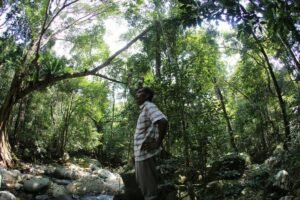
Editors’ note: This article is from the fall 2022 issue of the Nonprofit Quarterly, “The Face of Climate Change.”
Click here to download this article as it appears in the magazine, with accompanying artwork.
In the middle of a heat wave in Madrid this July, I climbed five flights of stairs in the Círculo de Bellas Artes to attend a conference on the climate movement, “A Planet to Win: Where Do We Start?”1 The panel was held in a room at the top of the building, offering sweeping views of the sweltering city. Seventy-five people or so gathered to listen to the five panelists—a group of climate academics, activists, and journalists—answer the question that the summit’s title proposed.
But the question of “we” has always been a fraught one.2 Governments, corporations, and individuals are not actors with equal amounts of influence. The fossil fuel industry alone is responsible for the majority of global carbon emissions in the past four decades.3 Between 1990 and 2015—a “critical 25-year period of unprecedented emissions growth”—the wealthiest one percent of the planet emitted “more than twice as much . . . as the 3.1 billion people who made up the poorest half of humanity.”4 Countries in the Global North are far more responsible for carbon pollution than countries in the Global South, which feel its effects the most.5
The problem of where—or rather, how—to begin with climate change mitigation is essentially the focus of the most recent report in April from the U.N. Intergovernmental Panel on Climate Change (IPCC), which states plainly that humanity’s ability to reverse and reduce the effects of climate change depends almost entirely upon the political willpower of governments to implement coordinated and large-scale interventional strategies.6 Yet social transformation on this scale has not historically happened without concerted struggle by ordinary people demanding what they need to survive.
Without economic transformation, just transitions, and green new deals, the world’s population will unevenly experience the accelerating catastrophe of planetary death—and the conference began by endowing “us” with purpose to shift the multiple and uneven paradigms of climate inequality. Bringing together climate experts from the United States, Europe, and South America, it attempted to paint a picture of where the international ecosocialist climate movement—which seeks to confront the interrelated crises of capitalism and climate change through democratic transformations of the economy, the state, and social relations—stands today.
The event was convened by Contra el diluvio, an organization dedicated to revealing the consequences of climate change to the public. Based in Madrid and founded in 2017, its name echoes a line in Karl Marx’s Capital, “Après moi, le deluge!”: “[After me, the flood!] is the motto of every capitalist and every capitalist nation. That is why capital does not take into consideration the health or the length of life of the worker, unless society forces it to do so.”7 Marx’s phrase repeats a quip attributed to King Louis XV of France, giving voice to capitalism’s nihilistic tendency to move society toward a crisis pitch with disregard for what disaster follows. To counter this indifference on behalf of the powerful, the organization took its name, which translates as “against the deluge,” or “against the flood.”
The group’s goal has been to help introduce climate narratives and demands into social movement organizations in Madrid—from tenants’ rights groups to racial justice organizations. Initially self-funded, the group has hosted debates, disseminated articles, translated climate policy, and publicized information about climate change in the service of socialized knowledge. “Only the collective and organized action of those below will allow us to survive the coming deluge,” the organizers write.8
“What is it a climate movement should be, and who should it be for?” —Kate Aronoff
It was in this imperative spirit that people gathered to hear what the panelists had to say about what is to be done. Kate Aronoff, journalist at the New Republic and coauthor of A Planet to Win: Why We Need a Green New Deal (2019), began with the American situation. She offered a succinct prehistory of the Green New Deal in the United States, tracing its emergence from a particular group of political movements rooted in critiques of inequality and principles of social justice that emerged in 2011, 2013, and 2016, respectively: Occupy Wall Street, Black Lives Matter, and Standing Rock. The forces inherent in these overlapping movements—demands for economic, climate, and racial justice—pushed the liberal mainstream climate imaginary into more intersectional territory by, for example, linking carbon taxes to anticorporate sentiment, or disinvestment in predominantly Black and Brown community infrastructure to green transportation demands. The Green New Deal framework has since been taken up by racial justice groups, such as the Movement for Black Lives—which has helped shape the aspirational horizon of its vision with calls for a Red, Black & Green New Deal,9 adding calls for reparations to those for decarbonization—and the Red Nation’s Red Deal, which pushes the Green New Deal further, as well as centers Indigenous people, history, and knowledge in the fight for climate justice.10 In Aronoff’s words, connecting climate justice to issues of racial and gender inequality reframes climate action as a question of democratic movements: “What is it a climate movement should be, and who should it be for?”
The climate movement resurfaced in mainstream political discussion eight years after that burst of uprisings, in 2016, when Senator Bernie Sanders’s (D-VT) bid for the presidency reoriented the U.S. left to the possibilities of electoral politics. The Democratic party began to champion climate legislation from within the Capitol; in 2018, Representative Alexandria Ocasio-Cortez (D-NY), backed by the energy of the youth-led activist group Sunrise Movement,11 and together with Senator Ed Markey (D-MA), introduced the Green New Deal— legislation laying out a plan for the large-scale social and political action necessary to decrease corporate carbon emissions, reduce dependence on fossil fuels, and create jobs in clean energy industries.12 The proposals were not necessarily new; the Green New Deal has been an embattled political talking point since at least the early 2000s,13 claimed by major political parties and articulated within opinion columns.14 But when Sunrise protestors, eventually joined by newly elected members of Congress, staged a sit-in outside of House Speaker Nancy Pelosi’s office in November of that year, it became clear that the calls for climate policy action were coming from both inside and outside the House.15
The proof that this climate movement had real influence came in the run-up to the 2020 election, Aronoff explained, during which Democratic candidates were competing with each other over how many trillions they would spend to mitigate the crisis, using the language of the Green New Deal put forward by climate activists. Every single candidate pledged “‘net-zero’ emissions by 2050 or earlier,” but most of these campaign-trail promises never materialized.16 “We won part of the debate but none of the hegemony,” as Aronoff put it during the conference. The problem is, nothing short of hegemony will change the course of humanity. “We need a solution at the scale of the crisis,” she emphasized, “a massive reinvestment program to reframe climate politics from austerity, lifestyle changes, and market tweaks to a redistribution of resources.” These ideas are popular and achievable, but the U.S. political system is uniquely and perhaps strategically bad at translating massive public support into policy. “There is no path toward decarbonization that doesn’t run through democratic majorities—but the U.S. isn’t a democracy.”
“When someone tells you the apocalypse is coming,” Daniel Aldana Cohen said, following Aronoff’s remarks, “you should pay attention.” Cohen, assistant professor of sociology at the University of California, Berkeley, coauthor of A Planet to Win, and founding codirector of the progressive climate policy think tank Climate and Community Project, stressed the pragmatic tenor of climate demands today. “The Green New Deal,” he explained, “was a radical idea about public-led investment planning the coordination of tens of trillions of dollars to physically rebuild the world and reinvest in disinvested communities.” Today, as the IPCC report denotes, these radical ideas have become reasonable.
To this end, Cohen mentioned the importance of publicizing “climate justice you can touch,” real-world examples of efforts to realize this necessary vision and building of coalitions around concrete proposals, such as recent efforts in Rhode Island to build state-run public housing.17 In a follow-up interview, I asked Cohen to elaborate on what it takes to synthesize a mass movement with concrete policy demands. In his research on battles against green gentrification in São Paulo, Cohen said, he realized that housing movements were “low- carbon protagonists, since they are actually fighting for both density and affordability: affordable housing near jobs, transit, and services.” He continued, “Housing movements led by women of color all across the Americas have as good or better visions for the green city than most environmentalists.”18 Bringing this principle back home, Cohen worked over the course of two years in the realms of fieldwork, journalism, and policy proposals to propose a Green New Deal for Housing.19
The important insight that emerged from this work was the necessity of democratic participation to building political power behind climate transformation. Cohen was invited by Representative Alexandria Ocasio- Cortez’s allies to talk about his ideas to organizers in New York working on public housing, where he emphasized the improvements to quality of life that the Green New Deal could provide, such as better kitchens and improved health conditions. At every step of the way, speaking to residents in public housing shaped his research and proposals for public housing transformation. The proposal for a Green New Deal for Housing, initially started in New York, was further shaped by community input when Cohen brought it to the think tank he cofounded and directs, the Climate and Community Project.20 Residents were invited to comment on and review proposals, shown illustrations of retrofits, and asked what they would want their apartments to look like. That proposal was eventually coopted by Senate Majority Leader Chuck Schumer (D-NY), who proposed
$80 billion for public housing retrofits in the Biden administration’s Build Back Better plan—which, according to Cohen, was less than what the coalition had asked for but much more than any politician had ever seriously proposed. And getting expansive funding commitments for public housing into the biggest social spending package proposed in decades is an organizing win.
Cohen said,
Sign up for our free newsletters
Subscribe to NPQ's newsletters to have our top stories delivered directly to your inbox.
By signing up, you agree to our privacy policy and terms of use, and to receive messages from NPQ and our partners.
To me, the big lesson is this: When there are underlying material commonalities for social and climate justice, research and organizing can bring those to the fore in innovative, synthetic, holistic proposals. And when movements are strong, and their political allies are strong, this can translate into some of the most serious policy out there. We haven’t figured out how to defeat the right. But we’re building a progressive Green New Deal left like no one imagined. And it’s all about the fusion of social movements, and their allies, across issue areas. If research and writing can help that process along a tiny bit, all the better. There really is a progressive climate politics under construction right now. If we can build it with working class tenant movements of color, we can sure as hell build it across the rest of society—in this country and around the world.21
Cohen and Aronoff’s perspectives on climate politics counter the paralytic defeatism of the U.S. political machine with the optimistic energy of organizing climate coalitions. The problems of climate politics become more complicated, however, when they expand to the planetary scale. Thea Riofrancos, associate professor of political science at Providence College and coauthor with Aronoff and Cohen of A Planet to Win, spoke about the challenges of producing green technologies for renewable energy sources that cross borders without reproducing the inequalities of fossil capitalism. Riofrancos’s research focuses on lithium mining, a global supply chain operation present across locations in Spain, Portugal, Chile, the United States, and elsewhere, and serves as a good example of the sprawling nature of the extractive economy and the challenges of transforming it.
How can the principles of the Green New Deal be applied to these complex chains? Focusing on the built environment, engineering, and design can be the crux of an internationalist climate politics that brings together disparate interests across the globe. “Each car we get off of the road, the less minerals we have to pull out of the ground,” said Riofrancos. “Chileans resisting lithium mining in their communities don’t want mining to happen; how could that be aligned with people who need transit in the U.S.?” Her answer knit together the political interests of both groups: In a world with mass transit, there is less need for electric vehicles (EVs). In this way, she added, we can move away from the idea that there is a divide between local struggles for participatory rights and global struggle for control over resources.
To build a transformative, democratic mass movement, labor, community groups, and Indigenous activist movements should be looking to each other to connect, Riofrancos argued, rather than carving out “who counts” in a climate movement. But coalition building is a balancing act. Movements need the time and space to explore and land on what is needed—and who needs it—as they form alliances.
Finding the connective tissue within political contradictions is key to building collectivities that can collaborate on an international ecosocialist strategy. “Contradictions, dilemmas, and trade-offs all inhere in a transition,” Riofrancos explained. Is there a possibility for ecosocialist revolution at a global scale? If we do not currently have a global proletariat ready to seize the means of ecological production, then we need a transition. And the first step to transition is for climate coalitions to ask: Where is power? Who has it? And how can we take it?
Sitting and waiting for this revolution is not an option; instead, we need both disruptive organizing from communities and bold proposals from policy-makers. To build a transformative, democratic mass movement, labor, community groups, and Indigenous activist movements should be looking to each other to connect, Riofrancos argued, rather than carving out “who counts” in a climate movement. But coalition building is a balancing act. Movements need the time and space to explore and land on what is needed—and who needs it—as they form alliances; and groups that have historically been born out of and/or promulgated unjust practices in the name of “environmentalism” must evolve if they wish to genuinely partner with movements that have formed precisely because they weren’t allowed a seat at the table.
Locating power in order to democratize it among large-scale majorities is also the goal of the decolonization movement, which overlaps with the demands of a socialist climate movement—especially in Latin America—in complex and productive ways. Sabrina Fernandes, sociologist and Brazilian ecosocialist organizer, put this succinctly: “You can’t become an independent nation without dealing with extractivism. Energy sovereignty is a question of who owns the territory, and what is done with it.” But this minimum requirement can also be an important galvanizing tool, Fernandes explained. Large-scale destruction of the Amazon has reached a record high under Brazilian president Jair Bolsonaro’s tenure, associating him with destruction of the planet. Anyone opposing him politically must thus articulate an anti-extraction stance, which is not a difficult standard to meet. But the task of movements for social justice is not to let the bare minimum be the standard; there is also the hard work of making sure that progressive governments do not give up on the more radical and difficult demands that bring them to power.
Powerful coalitions between community groups and labor unions in South America are able to do just that by bringing principles of bargaining for the common good to the climate struggle. Fernandes explained to me that with these coalitions, advocating for environmentalism becomes less of a dangerous job: “Latin America is a very dangerous place to be an environmentalist—it’s where an environmentalist is at one of the highest risks of assassination in the world.”22 And for Indigenous leaders and defenders of Indigenous communities, it is even worse. “Indigenous communities have been the guardians of our ecosystems long before the modern environmental movement came to be,” Fernandes elaborated. “Indigenous genocide and ethnocide are at the core of practices that shape today’s ecological crisis. Working together with Indigenous groups in their struggle for territory and recognition is not only our responsibility in terms of human rights but also helps to advance the cause for climate justice by protecting peoples and territories from capital.”23
On-the-ground resistance by Indigenous associations in Brazil to legal usurpation of their land is one way of connecting decolonization efforts to climate ecosocialism. One such appropriation measure, the “Marco Temporal,” or “Milestone Thesis”—championed by large landowners, agribusiness, and mining companies— would eliminate territorial claims by Indigenous groups who cannot “prove” they were occupying that territory at the signing of Brazil’s new constitution in 1988. This legal loophole would effectively use the centuries of genocidal displacement of Indigenous communities to rob them of both sovereignty and participatory control—which has obvious damaging consequences, including ecological ones.24
Settling issues around territorial rights with ecosocialist support is a productive pathway to building coalitions that bring genuine democracy back into the picture. Without fully autonomous Indigenous communities, there is no future for ecosocialism.
With escalating crises—hunger, fascism, weather—come increased possibilities for overlap between the ecosocialist movement and others. But how do we build consensus around changes? Like Cohen, Fernandes championed the idea that for a climate transition to work, it has to be a building block for something else. A “socialism of convenience” or “low-carbon luxury” are simple ways to communicate that a just transition includes people becoming happier, having more free time, and having basic needs met. Shortening the work week, redistributing care, building mass transit, and greening housing are all efforts to make life easier for people, and that’s how the story of climate transition should be told. By centering the subject at the margins of every context, “the person living under constant vulnerability,” Fernandes said, we can lead ourselves to a climate politics that takes overlapping struggles into account.
Progress toward these goals is not linear. Hector Tejero, environmentalist and politician with the progressive party Más Madrid, spoke plainly about failure. In our historical context, Tejero explained, the Green New Deal is “destined to fail” based simply on the political setbacks it encountered in the past two decades—whether opposition from conservatives in the U.S. context or the cooptation by centrists in the European one. Add to that multiple levels of complication—pandemics, wars, economic crises—and it becomes impossible to imagine a straight line between our present state of inaction and a future state of ecosocialist abundance.
Thinking about failure as inherent in a movement is not a strategy of pessimistic realism. According to Tejero, it is the key to demanding more than we expect to achieve, knowing that we will achieve less than we need.
Echoing a quote attributed to the Irish writer Samuel Beckett, Tejero said, “The consequences of climate change are going to be so bad that we have to ‘try again, fail again, fail better.’”25 The way to begin trying is from the point that the climate crisis can always be made “less worse,” Tejero summed up, by both mitigation and adaptation: “We can always make the world a little bit less hot and a little bit more fair, and I think that’s a hopeful idea we must push in times of despair.” He pointed out that the COVID-19 pandemic was a time of fear and uncertainty, flagging political resolve, and increased attenuation to suffering. This is true of the climate crisis, too.
In conversation with one another, the panelists turned to the topics of debt cancellation, inflation reduction, reparations, anti-gentrification, and demilitarization as pathways to climate politics. The wide-ranging nature of these struggles shows that there are multiple avenues toward the struggle for ecological justice, and they are not always obviously connected or socially adjacent. It is the hard work of journalists, academics, organizers, activists, and policymakers to bridge those gaps between social movements, so that others worldwide can demand the possible.
“To be truly radical,” wrote the English Marxist Raymond Williams, “is to make hope possible rather than despair convincing.”26 This, according to Tejero and all the other panelists at “A Planet to Win,” is the main task of the climate movement today. After the talks, organizers from Contra el diluvio handed out posters depicting public luxury in social realist style. The heat had not diminished much, even at the hour of seven in the evening, as the sun had not yet set. Just a week later, Portugal was ablaze with wildfires that killed dozens and set thousands of acres of vineyards aflame. It can always be less worse. We should begin to make it so now.
Notes
- See “Un planeta que ¿Por dónde empezamos?” (“A Planet to Win: Where Do We Start?”), July 6, 2022, www.circulobellasartes.com/humanidades/planeta-ganar-donde-empezamos/.
- Ajay Singh Chaudhary, “We’re Not in This Together,” The Baffler, 51 (April 2020), thebaffler.com/salvos/were-not-in-this-together-chaudhary.
- Tess Riley, “Just 100 companies responsible for 71% of global emissions, study says,” The Guardian, July 10, 2017, theguardian.com/sustainable-business/2017/jul/10/100-fossil-fuel-companies-investors-responsible-71-global-emissions-cdp-study-climate-change.
- Oxfam International, “Carbon emissions of richest 1 percent more than double the emissions of the poorest half of humanity,” press release, September 21, 2020, oxfam.org/en/press-releases/carbon-emissions-richest-1-percent-more-double-emissions-poorest-half-humanity.
- Olúfémi Táíwò and Patrick Bigger, “The Global South Is Calling for Climate Reparations,” The Nation, April 22, 2022, www.thenation.com/article/environment/climate-reparations/.
- Working Group III Contribution to the IPCC Sixth Assessment Report, Climate Change 2022: Mitigation of Climate Change Intergovernmental Panel on Climate Change (Cambridge, UK, and New York, NY: Cambridge University Press, 2022).
- Translated from the Marx quoted at Contra el diluvio, “Quiénes somos,” accessed August 22, 2022, contraeldiluvio.es/quienes-somos/.
- Ibid.
- Cyndi Suarez, “Climate Justice: A Global Movement for Life,” Nonprofit Quarterly 28, 3 (Fall 2021): 8–13.
- Nick Estes, “A Red Deal,” Jacobin, August 6, 2019, com/2019/08/red-deal-green-new-deal-ecosocialism-decolonization-indigenous-resistance-environment.
- “We Are Sunrise Movement: We Are the Climate Revolution,” Sunrise Movement, accessed August 22, 2022, sunrisemovement.org/.
- Lisa Friedman, “What Is the Green New Deal? A Climate Proposal, Explained,” New York Times, February 21, 2019, nytimes.com/2019/02/21/climate/green-new-deal-questions-answers.html.
- Emily Atkin, “The Democrats Stole the Green Party’s Best Idea,” New Republic, February 22, 2019, com/article/153127/democrats-stole-green-partys-best-idea.
- “WE CAN build a better tomorrow, today: It’s time for a Green New Deal,” Green Party of the United States, accessed August 22, 2022, gp.org/green_new_deal; and Thomas L. Friedman, “A Warning From the Garden,” New York Times, January 19, 2007, www.nytimes.com/2007/01/19/opinion/19friedman.html.
- Ryan Grim and Briahna Gray, “Alexandria Ocasio-Cortez Joins Environmental Activists in Protest at Democratic Leader Nancy Pelosi’s Office,” The Intercept, November 13, 2018, com/2018/11/13/alexandria-ocasio-cortez-sunrise-activists-nancy-pelosi/.
- “Energy, Environment & Climate Change,” Politico, last modified February 19, 2020, politico.com/2020-election/candidates-views-on-the-issues/energy-environment/.
- Rachel Cohen, “How state governments are reimagining American public housing,” Vox, August 4, 2022, www.vox.com/policy-and-politics/23278643/affordable-public-housing-inflation-renters-home.
- Interview by the author with Daniel Aldana Cohen, July 7 and 27,
- Daniel Aldana Cohen, “A Green New Deal for Housing,” Jacobin, February 8, 2019, com/2019/02/green-new-deal-housing-ocasio-cortez-climate.
- Climate and Community Project, accessed September 12, 2022, climateandcommunity.org/.
- Interview by the author with Cohen, July 7 and 27,
- Interview by the author with Sabrina Fernandes, July 19, And see Scott Neuman, “It Was The Deadliest Year Ever For Land And Environmental Activists,” National Public Radio, September 13, 2021, www.npr.org/2021/09/13/1036575970/killing-land-climate-environmental-activist-global-witness.
- Interview by the author with
- Andrew Fishman, “Brazil’s Indigenous Groups Mount Unprecedented Protest Against Destruction of the Amazon,” The Intercept, August 28, 2021, com/2021/08/28/brazil-amazon-indigenous-protest/.
- The full quote is “Ever Ever failed. No matter. Try again. Fail again. Fail better.”
- Derek Wall, “Culture is ordinary: the politics and letters of Raymond Williams,” Culture Matters, May 25, 2016, culturematters.org.uk/index.php/culture/theoryitem/2310-culture-is-ordinary-the-politics-and-letters-of-raymond-williams.











